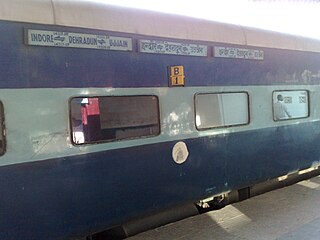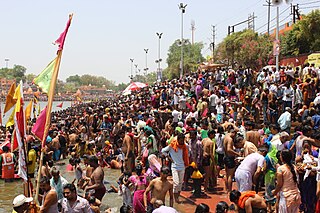Related Research Articles

Haridwar is a city and municipal corporation in the Haridwar district of Uttarakhand, India. With a population of 228,832 in 2011, it is the second-largest city in the state and the largest in the district.

Kumbh Mela is an important Hindu pilgrimage, celebrated approximately every 6, 12 and 144 years, correlated with the partial or full revolution of Jupiter and representing the largest human gathering in the world.

Ujjain or Ujjayinī is a city in Ujjain district of the Indian state of Madhya Pradesh. It is the fifth-largest city in Madhya Pradesh by population and is the administrative centre of Ujjain district and Ujjain division. It is one of the Hindu pilgrimage centres of Sapta Puri famous for the Kumbh Mela (Simhastha) held there every 12 years. The famous temple of Mahakaleshwar Jyotirlinga is located in the center of the city. The city has been one of the most prominent trade and political centres of the Indian Subcontinent from the time of the ancient Mahājanapadas until the British colonisation of India.

Mela is a Sanskrit word meaning "gathering" or "to meet" or a "fair". It is used in the Indian subcontinent for all sizes of gatherings and can be religious, commercial, cultural or sport-related. In rural traditions melas or village fairs were of great importance. This led to their export around the world by South Asian diaspora communities wishing to bring something of that tradition to their new countries.

Haridwar district, also spelled Hardwar, is part of Uttarakhand, India that lies in the Doab region, where people traditionally speak Khariboli. It is headquartered at Haridwar which is also its largest city. The district is ringed by the districts Dehradun in the north and east, Pauri Garhwal in the east and the Uttar Pradesh districts of Muzaffarnagar and Bijnor in the south and Saharanpur in the west.
Laksar is a small town, near Haridwar city and Nagar Palika in Haridwar district of the Indian state of Uttarakhand, situated along National Highway 334A. It is an important sugar manufacturing destination in the state and also known for the Laksar Junction railway station (LRJ), the largest railway junction in the state, which was built in 1866.

In Hinduism, the yatra (pilgrimage) to the tirthas has special significance for earning the punya needed to attain the moksha (salvation) by performing the darśana, the parikrama (circumambulation), the yajna, the Dhyana, the puja (worship), the prarthana, the dakshina, the seva, the bhandara, etc. These sacred places are usually located on the banks of sacred waters, such as sacred rivers or their tributaries, the kundas, the ghats, or the stepwells, or the temple tanks.

Yatra, in Indian-origin religions, Hinduism, Buddhism, Jainism and Sikhism, generally means a pilgrimage to holy places such as confluences of sacred rivers, sacred mountains, places associated with Hindu epics such as the Mahabharata and Ramayana, and other sacred pilgrimage sites. Visiting a sacred place is believed by the pilgrim to purify the self and bring one closer to the divine. The journey itself is as important as the destination, and the hardships of travel serve as an act of devotion in themselves.

Har Ki Pauri, meaning the feet of Lord Vishnu (Hari), is a ghat on the banks of the river Ganga and landmark of the Hindu holy city of Haridwar in the Indian state of Uttarakhand.

Ramesh Pokhriyal "Nishank", is an Indian politician from Bhartiya Janta Party. He served as the Human Resource Development Minister in the Union Government of India starting from 31 May 2019. The name of his ministry was changed to Education Ministry in July 2020, following the ministry's name change, his title was changed to Minister of Education.

The Sapta Puri are a group of seven Hindu tirtha, or holy pilgrimage sites, located in India. Pilgrimage to these sites is said to bless the pilgrim with moksha.
Chintaman Ganesh is the biggest temple of Lord Ganesha in Ujjain of Madhya Pradesh, India. This temple is built across the Kshipra river on the Fatehabad railway line, and is located about 7 km far south-westerly to the Ujjain town. The temple is located now in the middle of the town's market.

The Ujjaini Express is a bi-weekly train service, connecting Lakshmibai Nagar, a satellite station of Indore, the Commercial Capital of Madhya Pradesh, Ujjain railway station of the Hindu mythological and historical city of Ujjain in the Central Indian state Madhya Pradesh with Yog Nagari Rishikesh railway station.
Unlike some other religions, Hindus are not required to undertake pilgrimages during their lifetime. However, most Hindus go on such journeys to numerous iconic sites including those below:
On 10 February 2013, during the Hindu festival of Kumbh Mela, a stampede broke out at the train station in Allahabad, Uttar Pradesh, India, killing 42 people and injuring at least 45 people.
Shri Adinath Akhara, is an ashram dedicated to Shiva. It is situated 1.5 km from the Buxar railway station at the confluence of the Ganga and Sone canals.

Haridwar Kumbh Mela is a mela, associated with Hinduism and held in the city of Haridwar, India held every 12 years. The exact date is determined according to Hindu astrology: the Mela is held when Jupiter is in Aquarius and the Sun enters Aries. The event possesses deep religious significance to Hindus as well as other spiritual seekers. Historically, it was an important commercial event and was attended by merchants from as far as Arabia.

Ujjain Simhastha is a Hindu religious mela held every 12 years in the Ujjain city of Madhya Pradesh, India. The name is also transliterated as Sinhastha or Singhastha. In Hindi, the fair is also called Simhasth or Sinhasth. The name derives from the fact that it is held when the Jupiter is in Leo.

Nirmala also known as Nirmala Saṁpardā or Nirmal Paṅth, is a Sikh sect of ascetics. According to the traditional beliefs, the Sanatan Nirmala Sikh tradition was founded by Guru Gobind Singh in late 17th century when he sent five Sikhs to Varanasi to learn Sanskrit and Vedanta texts.

Nashik-Trimbakeshwar Simhastha is a Hindu religious mela held every 12 years in the Nashik district of Maharashtra, India. The name of the festival is also transliterated as Sinhastha or Singhastha. It is one of the four fairs traditionally recognized as Kumbha Melas, and is also known as Nashik-Trimbak Kumbha Mela or Nashik Kumbha Mela.
References
- ↑ Reuter, Mohan Narvaria (16 July 1996). "60 Hindus die in festival crush" . Haridwar and Ujjain, India: The Independent. Archived from the original on 1 May 2022. Retrieved 6 July 2014.